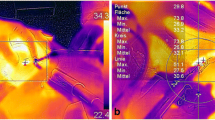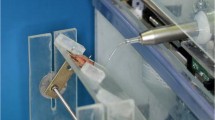Abstract
Purpose
The aim of this study is to compare the repair of incisions performed with microdissection electrocautery tip, conventional electrocautery tip, high potency diode laser, and conventional scalpel blade in a in vivo model.
Methods
Different incisions were performed in adults Holtzman rats using the four types of instruments: microdissection electrocautery tip, conventional electrocautery tip, high potency diode laser, and conventional scalpel blade, in different periods of healing process. Thirty rats were divided into 5 groups, according to the period of euthanasia—24 h, 48 h, 72 h, 7 days, and 14 days. All animals received four incisions, each by a different method. Quantitative histological and histomorphometric analyses were performed using hematoxylin and eosin (HE) and Picrosirius Red staining.
Results
Inflammatory profile and tissue repair presented small statistically significance differences comparing conventional scalpel blade and microdissection tip; moreover, both presented quantitatively superior to the others.
Conclusion
It is believed that the microdissection tip can perform a dynamic incision just as a common scalpel blade, but more effective. Furthermore, it can promote a better hemostatic control of the surgical field that is comparable to conventional electrocautery tip without affecting tissue repair.




Similar content being viewed by others
References
Jaeger F, Chiavaioli GM de O, de Toledo GL, Freire-Maia B, Amaral MBF, de Abreu MHNG et al (2020) Efficacy and safety of diode laser during circumvestibular incision for Le Fort I osteotomy in orthognathic surgery: a triple-blind randomized clinical trial. Lasers Med Sci 35(2):395–402
Jin J-Y, Lee S-H, Yoon H-J (2010) A comparative study of wound healing following incision with a scalpel, diode laser or Er, Cr:YSGG laser in guinea pig oral mucosa: a histological and immunohistochemical analysis. Acta Odontol Scand 68(4):232–238
Agren MS, Mertz PM, Franzen L (1997) A comparative study of three occlusive dressings in the treatment of full-thickness wounds in pigs. J Am Acad Dermatol 36(1):53–58
Krafts KP (2010) Tissue repair: the hidden drama. Organogenesis 6(4):225–233
Massarweh NN, Cosgriff N, Slakey DP (2006) Electrosurgery: history, principles, and current and future uses. J Am Coll Surg 202(3):520–530
Gelman CL, Barroso EG, Britton CT, Haklin MF, Staren ED (1994) The effect of lasers, electrocautery, and sharp dissection on cutaneous flaps. Plast Reconstr Surg 94(6)
Angiero F, Parma L, Crippa R, Benedicenti S (2012) Diode laser (808 nm) applied to oral soft tissue lesions: a retrospective study to assess histopathological diagnosis and evaluate physical damage. Lasers Med Sci 27(2):383–388
Rich L, Whittaker P (2005) Collagen and picrosirius red staining: a polarized light assessment of fibrillar hue and spatial distribution. J Morphol Sci 22(2):97–104
Nagargoje GL, Badal S, Mohiuddin SA, Balkunde AS, Jadhav SS, Bholane DR (2019) Evaluation of electrocautery and stainless steel scalpel in oral mucoperiosteal incision for mandibular anterior fracture. Ann Maxillofac Surg 9(2):230–234
Aird LNF, Brown CJ (2012) Systematic review and meta-analysis of electrocautery versus scalpel for surgical skin incisions. Am J Surg 204(2):216–221
Ram M, Singh V, Kumawat S, Kant V, Tandan SK, Kumar D (2016) Bilirubin modulated cytokines, growth factors and angiogenesis to improve cutaneous wound healing process in diabetic rats. Int Immunopharmacol [Internet] 30:137–49. Available from: https://doi.org/10.1016/j.intimp.2015.11.037
Lattouf R, Younes R, Lutomski D, Naaman N, Godeau G, Senni K et al (2014) Picrosirius red staining: a useful tool to appraise collagen networks in normal and pathological tissues. J Histochem Cytochem 62(10):751–758
Bornstein E (2004) Near infra red dental diode lasers. Scientific and photobiologic principles and applications. Dent Today 23:102–8
Sharma R (2012) Safety of colorado microdissection needle (stryker) for skin opening in craniomaxillofacial surgery. J Maxillofac Oral Surg 11(1):115–118
Bashetty K, Nadig G, Kapoor S (2009) Electrosurgery in aesthetic and restorative dentistry: a literature review and case reports. J Conserv Dent 12(4):139–144
Dayan D, Hiss Y, Hirshberg A, Bubis JJ, Wolman M (1989) Are the polarization colors of Picrosirius red-stained collagen determined only by the diameter of the fibers? Histochemistry 93(1):27–29
Butler PEM (1991) Improved wound healing with a modified electrasurgical electrode 1(15)
D’Arcangelo C, Di Nardo Di Maio F, Prosperi GD, Conte E, Baldi M, Caputi S (2007) A preliminary study of healing of diode laser versus scalpel incisions in rat oral tissue: a comparison of clinical, histological, and immunohistochemical results. Oral Surg Oral Med Oral Pathol Oral Radiol Endod 103(6):764–73
Chandra RV, Savitharani B, Reddy AA (2016) Comparing the outcomes of incisions made by colorado microdissection needle, electrosurgery tip, and surgical blade during periodontal surgery: a randomized controlled trial. J Indian Soc Periodontol 20(6):616–622
Kara C (2008) Evaluation of patient perceptions of frenectomy: a comparison of Nd:YAG laser and conventional techniques. Photomed Laser Surg 26(2):147–152
Wilder-Smith P, Arrastia AM, Liaw LH, Berns M (1995) Incision properties and thermal effects of three CO2 lasers in soft tissue. Oral Surg Oral Med Oral Pathol Oral Radiol Endod 79(6):685–691
Smith KC (1991) The photobiological basis of low level laser radiation therapy. LASER Ther 3(1):19–24
Johnson MA, Gadacz TR, Pfeifer EA, Given KS, Gao X (1997) Comparison of CO2 laser, electrocautery, and scalpel incisions on acute-phase reactants in rat skin. Am Surg 63(1):13–16
Azevedo LH, de Sousa SCOM, Correa L, de Paula EC, Dagli MLZ, Romanos G et al (2008) Mast cell concentration in the wound healing process of incisions made by different instruments. Lasers Med Sci 24(4):585
Acknowledgements
The authors would like to thank São Paulo Research Foundation (FAPESP) for supporting the research.
Funding
The authors declare that this work was supported by São Paulo Research Foundation (FAPESP), grant #2017/19363–7.
Author information
Authors and Affiliations
Contributions
All authors contributed to the study conception and design. Material preparation, data collection, and analysis were performed by Renato Torres Augusto Neto, Cássio Amaro Comachio, Pedro Henrique de Azambuja Carvalho, Guilherme dos Santos Trento, and Valfrido Antônio Pereira-Filho. The first draft of the manuscript was written by Renato Torres Augusto Neto and all authors commented on previous versions of the manuscript. All authors read and approved the final manuscript.
Corresponding author
Ethics declarations
Ethics approval
All procedures performed during studies involving animals were in accordance to ARRIVE (Animal Research: Reporting of In Vivo Experiments) and with the ethical standards of the institution at which the studies were conducted—ethical approval was obtained by Animal Use Ethics Committee (CEUA) (Process nº 08/2017) from Araraquara Dental School, Sao Paulo State University – UNESP.
Consent to participate
Not applicable for this study.
Consent for publication
Not applicable for this study.
Competing interests
The authors declare no competing interests.
Additional information
Publisher's note
Springer Nature remains neutral with regard to jurisdictional claims in published maps and institutional affiliations.
Springer Nature or its licensor holds exclusive rights to this article under a publishing agreement with the author(s) or other rightsholder(s); author self-archiving of the accepted manuscript version of this article is solely governed by the terms of such publishing agreement and applicable law.
Supplementary information
Below is the link to the electronic supplementary material.
Rights and permissions
Springer Nature or its licensor holds exclusive rights to this article under a publishing agreement with the author(s) or other rightsholder(s); author self-archiving of the accepted manuscript version of this article is solely governed by the terms of such publishing agreement and applicable law.
About this article
Cite this article
Torres-Augusto Neto, R., Comachio, C.A., de Almeida, L.C.Q. et al. Tissue response to different incision tools in animal model. Oral Maxillofac Surg 27, 631–638 (2023). https://doi.org/10.1007/s10006-022-01105-7
Received:
Accepted:
Published:
Issue Date:
DOI: https://doi.org/10.1007/s10006-022-01105-7




